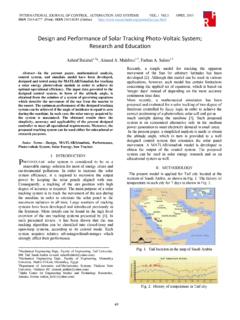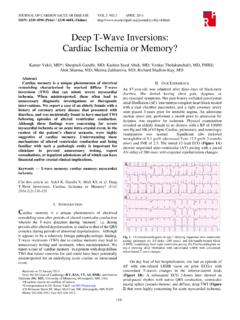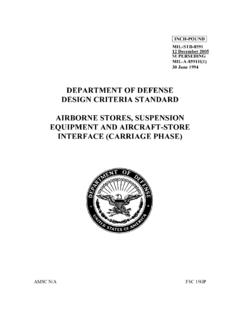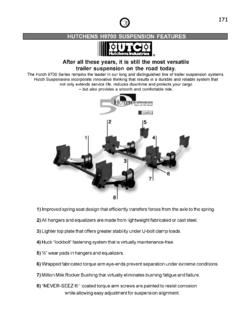Transcription of Car Suspension Control Systems: Basic Principles
1 INTERNATIONAL JOURNAL OF Control , AUTOMATION AND SYSTEMS , , JANUARY 2012 41 Abstract increased competition on the automotive market has forced companies to research alternative strategies to classical passive Suspension systems. In order to improve handling and comfort performance, instead of a conventional static spring and damper system, semi-active and active systems are being developed. The paper has been written in two parts. This first part reviews the Basic types of car Suspension systems which range from simple spring-dampers, through semi-active dampers, and active suspensions systems.
2 As the purpose of a Suspension system is to support the vehicle body and increase ride comfort. The second part discusses the conflicting of these two requirements. Index Terms Active Suspensions; Vehicle System; rid comfort. I. INTRODUCTION An active Suspension system possesses the ability to reduce acceleration of sprung mass continuously as well as to minimize Suspension deflection, which results in improvement of tire grip with the road surface, thus, brake, traction Control and vehicle maneuverability can be considerably improved. Today, a rebellious race is taking place among the automotive industry so as to produce highly developed models.
3 One of the performance requirements is advanced Suspension systems which prevent the road disturbances to affect the passenger comfort while increasing riding capabilities and performing a smooth drive. While the purpose of the Suspension system is to provide a smooth ride in the car and to help maintain Control of the vehicle over rough terrain or in case of sudden stops, increasing ride comfort results in larger Suspension stroke and smaller damping in the wheel hop mode [1]. In this review, an automatic Suspension system for a quarter car is explored to highlight the different technological processes used for Suspension systems such as shown in a.
4 Schematic quarter car model, [2] Car Suspension System Car Suspension Control Systems: Basic Principles Ayman A. Aly *Dr. Ayman A. Aly is with Mechatronics Section, Faculty of Engineering, Taif University, Taif, 888, Saudi Arabia, on leave from Mechatronics Section, Faculty of Engineering, Assiut University, Assiut 71516, Egypt, CAR Suspension Control SYSTEMS: Basic Principles 42 II. Principles OF Suspension SYSTEM Passive suspensions as shown in can only achieve good ride comfort or good road holding since these two criteria conflict each other and necessitate different spring and damper characteristics.
5 While semi-active suspense with their variable damping characteristics and low power consumption, on systems offer a considerable improvement, (see ) [3, 4[. A significant improvement can be achieved by using of an active Suspension system, (see ) which supplied a higher power from an external source to generate Suspension forces to achieve the desired performance. The force may be a function of several variables which can be measured or remotely sensed by various sensors, so the flexibility can be greatly increased. Passive Suspension system Semi active Suspension system With rapid advances in electronic technologies [5], The development of design techniques for the synthesis of active vehicle Suspension systems has been an active area of research over the last two decades to achieve a better compromise during various driving conditions.]]
6 [6-11]. Active Suspension system Automotive companies are competing to make more developed cars, while comfort of passengers is an important demand and everyone expects from industries to improve it day by day. Therefore, in order to provide a smooth ride and satisfy passengers comfort, designing a modern Suspension system is mandatory. A good and efficient Suspension system must rapidly absorb road shocks and then return to its normal position, slowly. However, in a passive Suspension system with a soft spring, movements will be high, while using hard springs causes hard moves due to road roughness [12-18].
7 Therefore, it s difficult to achieve good performance with a passive Suspension system. II. THE CONFLICTING IN CAR SUSPENSIONS SYSTEMS DESIGN In order to fulfill the objective of designing an active Suspension system to increase the ride comfort and road handling, there are three parameters to be observed in the simulations. The three parameters are the wheel deflection, dynamic tire load and car body acceleration. For definition of the allowable limits of car body acceleration, there is a frequency domain where human beings are most sensitive to vibration (human sensitivity band).
8 Fig. 3 give a measured result from a report of ISO/DIS 5349 & ISO 2631 - 1978, which shows the human endurance limit to frequency band to vertical acceleration is 4 ~ 8Hz, which means that for the purpose of improving the ride comfort the car body acceleration gain should be in this range [19]. INTERNATIONAL JOURNAL OF Control , AUTOMATION AND SYSTEMS , , JANUARY 2012 43 The typical transfer-functions of the quarter-car model for the normalized body acceleration and tire load in respect to the road excitation are shown in Fig. 4 [20]. In order to improve the ride quality, it is important to isolate the body, also called sprung mass, from the road disturbances and to decrease the resonance peak of the sprung mass near 1 Hz, which is known to be a sensitive frequency to the human body.
9 In order to improve the ride stability, it is important to keep the tire in contact with the road surface and therefore to decrease the resonance peak near 10 Hz, which is the resonance frequency of the wheel also called unsprung mass. Transmissibility of vertical vibration from table to human body[20] Vertical vibration exposure criteria curves[20] Therefore, the ride quality and the drive stability are two conflicting criteria. Fig. 5, [21] illustrates this conflict, showing the variation of drive safety and comfort with the changing vehicle parameters body mass, stiffness and damping in the "conflict diagram".
10 The conflict diagram presents the vehicles properties, driving comfort and safety for a defined maneuver order to improve the ride stability. Fig. 4 Frquency response magntiude for normalized body acceleration and tire load for a passive suspention system, [21] Influence of vehicle parameters, qurater car simulation, [21] CAR Suspension Control SYSTEMS: Basic Principles 44 Fig. 6 Comparison between passive, adaptive, semi-active system, [22] As can be seen from Fig. 6, the fixed setting of a passive Suspension system is always a compromise between comfort and safety for any given input set of road conditions on one hand and payload Suspension parameters on the other.












